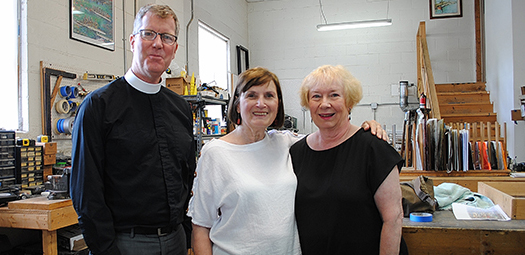
Visiting Kelly Art Glass in Millvale
By Laurie Cohen, PHLF member

Church of the Redeemer members from left: Reverend Michael Foley; Karen Esch, chair of the Windows Fund Campaign; and Patricia Edgar, Chair of the church’s restoration committee. Photo by Laurie Cohen.
On Sunday, September 15th, twenty-three members of Church of the Redeemer in Squirrel Hill visited Kelly Art Glass in Millvale. The church is one of the recipients this year of a matching grant from PHLF’s Historic Religious Properties Program. As a result, Kelly Art Glass is restoring four stained-glass windows from Redeemer, including the replacement of plexiglass with vented storm windows.
John Kelly, founder of Kelly Art Glass, and two of his assistants greeted everyone and explained why older windows sometimes need to be restored. In the U.S., it was generally thought that lead had a lifespan of 80 to 100 years, but when glass historians visited French cathedrals and churches, they noticed that the windows were still in place after more than 400 years. The reason is that the French added 2% of antimony to the lead, a practice that was incorporated in U.S. lead production beginning in the 1960s.
In preparing to restore art-glass windows, John always looks into the work and history of the original artist. Redeemer windows were created by Howard Gilman Wilbert between 1939 and 1962. Wilbert was the founder of Pittsburgh Stained Glass Studio, the foremost glass painters of their day. He was known for his complicated and beautiful designs. Church of the Redeemer is the only church in the United States where Wilbert designed all the windows.
For many years, it was common for churches to use plastic storm windows to protect them from the elements or from damage. Unfortunately, the air pocket created between the storm window and stained glass would cause heat to build up, which then would cause the relatively soft lead to buckle. When lead buckles, it takes the window with it, so the window requires “re-lead restoration.” Using a flexible, silicone caulk allows movement of the material, and replacing the plastic with vented-glass storm windows allows the air to circulate. The restoration increases air circulation, pressure equalization, and ultimately, the longevity of the windows.
John described the process of removing the Church of the Redeemer windows for repair. It was a delicate task because of their condition. The team built a wooden shipping-container-like structure, containing Styrofoam and bubble wrap, to protect the transfer from the Squirrel Hill church to the Millvale studio. No scaffolding was used, which church members appreciated.
During the restoration, glass worker Pete Boucher discovered an unusual practice. Pieces of glass were hidden behind the lead with the words “by Mr. and Mrs. John Sherriff” etched onto the window. It is rare to find donors’ names incorporated into the glass.
The narthex screen had buckled, so brass strips were added through the glass to strengthen the window. In some cases, glass was added to increase the visibility of the scenes depicted. In places where glass was broken, the color had to be matched and painted over.
John and his assistants walked the visitors through the process of glass and lead restoration. First, a template of the window is created by laying a piece of paper over the window and chalking out the outline to create a rubbing. The individual pieces of glass are then laid to soak in a tray of non-detergent solvent for several days, in order to dissolve concrete or any other substance, and are scrubbed. The clean pieces are then placed over the rubbing in the places where they will be reattached, and outlines of the pieces are drawn. The outlines of the glass are nailed into the plywood underneath the rubbing to hold them in place. The thicker pieces of glass are used to create shading. Finally, all of the pieces are held together by the lead.
Stained-glass window restoration is a thorough undertaking. It sometimes takes years of research to understand the windows’ history and construction before restoration itself can begin. Kelly Art Glass documents all its work, including recording field notes, before-and-after photos, correspondence regarding the windows, and a detailed description of the restoration process. This ensures that future generations know what work was done, so that if restoration technology changes, the necessary adjustments in the work can be made.
Church of the Redeemer members were enthusiastic during the tour and thanked PHLF for the opportunity to have their windows restored. Their enthusiasm was matched by John’s passion for his work and his delight in sharing some of his knowledge with the parishioners. He said that windows like these are an extremely personal investment, but they bring joy to parishioners and the public for generations.
